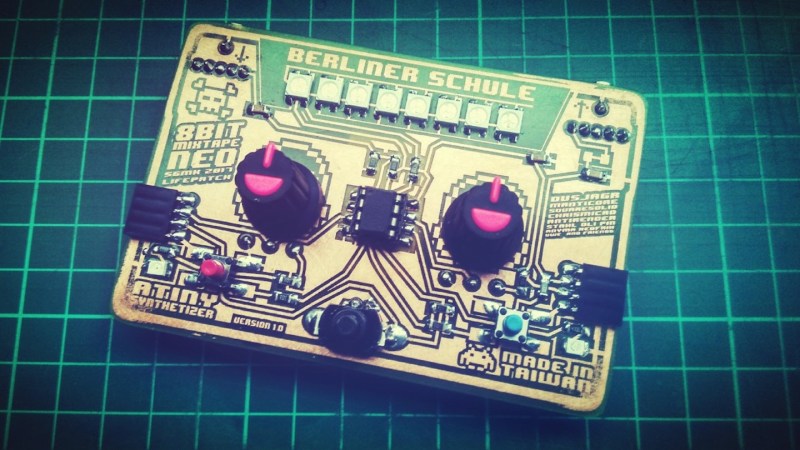8bit Mixtapes are simple Arduino-based sound and beat generators based on ATtiny 84s and 85s and designed fit inside old audio cassettes, or at least be about that size. Founded by [Dusjagr], [Ucok] and [Lyok], and including participants from around the globe, 8bit Mixtapes are small synthesizers that play one-line algorithmic symphonies, simple sound generators that work off of a single line of code.
The project has been going on for a number of years, with several different iterations released over the years–the most recent is the Mixtape NEO, released about a month ago that features audio bootloading and a row of NeoPixel LEDs. It’s well documented and fully open source, with a code repository and wiki. The arty PCBs look great as well!
8bit Mixtapes are a natural project for electronics students to tackle. An ATtiny85 with two pots and two buttons? Pretty simple, and the musical payoff makes it a cinch for one-day workshops. The code simplicity makes it easy to modify the software as well.
Quirky synths are Hackaday’s bag, including one we published previously that controls a hexagonal matrix of LEDs.
https://www.youtube.com/watch?v=Dveu7Udco8whttps://www.youtube.com/watch?v=BP1CbmxvEw0















Now let’s see one that actually plays in a cassette player. :-)
^this^
I was expecting a magnetic interface for the head of the tape player, but the top photo showed the knobs too high to fit in one….
This needs a clear tape shell to show off the beautiful pcb
I have a battery operated “Tape Head Demagnetizer” in a cassette form factor.
It is in a clear tape shell, and activated when inserted into a cassette player.
Ahja… we talked sooo many times about that idea! We also did some prototype that could fit back into a cassette player. just get rid of the potentiomenters.
an earliest edition 0.2 or something went towards this:
http://wiki.sgmk-ssam.ch/wiki/8bit_Mix_Tape#Parts
some versions are fit into existing tape cases, a bit fiddly and difficult to do at workshops, and we switched to artsy-tape styled PCB at some point, and 3d printed case.
another edition designed by GaudiLabs, not using the attiny85, is a fork from the spark fun fio3, but redesigned to fit nicely into a cassette tape case. see this nice video:
https://www.youtube.com/watch?v=rMRP7uCivyY
One of the coolest parts about this project you may have missed out on, is try made a whole nice Arduino library too where they PROGRAM THE TAPES WITH SOUND ! They compile the code into wav files! It’s great!
The TinyAudioBootloader is very cool.
I got a license to use it in my synthesizers.
Just plug the audio output to a sound source and replay a wavefile for uploading new sounds or firmware.
First synth to use it is my Synsonique Drums:
https://janostman.wordpress.com/2017/07/10/synsonique-drum/
http://hackaday.com/2011/09/09/program-an-arduino-using-your-sound-card/
There are commerical implementations of this. HaD has covered higher frequency communications in the past too.
Audio tx/rx certainly used in field applications both for programming and servicing/debugging commerical/consumer devices.
Doesn’t negate from the cool factor.;
Funny, I made the audio bootloader 2011 and now, 6 years later the people seem to use it.
>There are commerical implementations of this. HaD has covered higher frequency >communications in the past too.
Do you have some links?
I saw that one, I just didn’t get a chance to mention it. All in all a kick-ass series of projects.
Synths: How it’s made
https://www.youtube.com/watch?v=DRdPUTbZHz4
http://fallout.wikia.com/wiki/Synth
:o)
This unexpectedly awesome. Doesn’t get more 80s than an 8Bit cassette tape synth.
Here I made some more code examples for this project:
https://github.com/ChrisMicro/AttinySound
The PCBs you see there are compatible to the arts-versions.
Cool project-I had not heard of these. I love the simplicity of the build and there are lots of possibilities.
@ChrisMicro-thanks for the audiobootloader and the git link :) I have some weekend tinkering ahead it appears :)
Thanks :-)
I love the stop motion!
I use the same laminator for toner transfer and after watching this video I went and looked at mine and – yes – there is a reverse direction switch. DUH